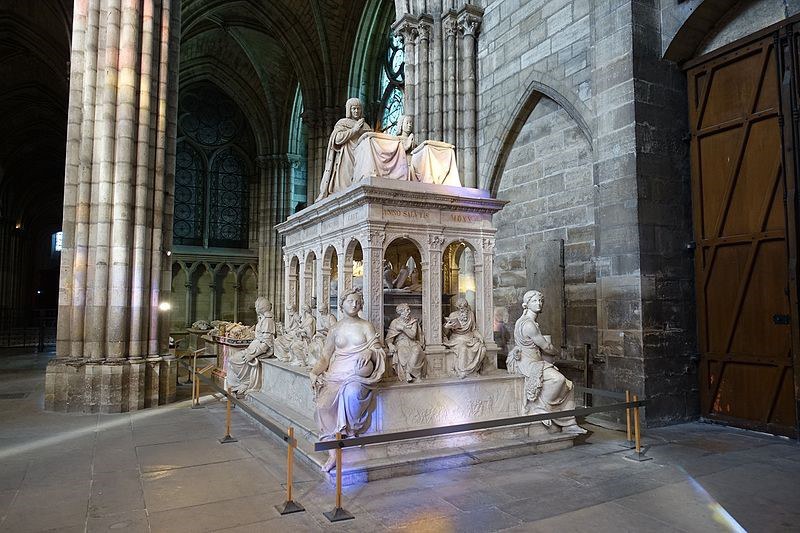The Funeral of Anne of Brittany
Anne died at the chateau of Blois on 9th January 1514, in what the Breton herald described as ‘the month of sorrow and lamentation’. Her widower, Louis XII, was reported to be deeply distressed by her death, although they had not always agreed on matters of policy – particularly the betrothal of their daughter, Claude.
In token of his grief, Louis arranged one of the most sumptuous funerals ever accorded to a French queen. Anne’s body was carried from her room, and placed in one of the state rooms of the chateau. The room, containing an altar, was draped in black velvet, covered with Anne’s coat-of-arms and heraldic symbols, and her favoured device of the cordelier.
Silk tapestries illustrated the destruction of Jerusalem, and the bed on which she was laid had a cloth-of-gold canopy. The queen was dressed in purple velvet, trimmed with ermine, and had a crown over the headdress. Her regal sceptre was in the right hand and the rod of justice in her left.
To the foot of the bed was a large gold cross, and basins of Holy Water. Over the following forty-eight hours, the court, dressed in black, came to pay its last respects.
After eight days (the body had been embalmed) the corpse was covered and placed in a wooden coffin.
On around the 26 January, (the day following Anne’s 38th birthday) the procession formed – led by François of Angouleme, as it was not customary for kings to attend funerals. Anne’s daughters are not mentioned. Renée was too young, aged only four, but perhaps Claude was too grief-stricken to take part. François was followed by Anne of Beaujeu, Duchess of Bourbon, and sister of Anne’s first husband; Louise of Savoy, Dowager Countess of Angoulême; then Louise's daughter, Marguerite, and Marguerite’s husband, the Duke of Alençon.
After the royal party, the court was headed by Anne’s chief lady, Madame de Mailly. Prominent amongst the mourners was John Stewart, Duke of Albany, who was, intermittently, Governor of Scotland for the minor king, James V.
The procession accompanied the coffin to the church of St Saveur in Blois. The next day, three masses were said, by the Bishops of Paris, Limoges and Bayeux. Anne’s confessor read the funeral oration – uttering thirty-seven praises of the late queen, one for each year of her life.
The cortège then left the church and began its slow journey to Paris, lit by 450 torches. Five days later, the coffin was transferred to a type of chariot, covered in black velvet with white satin crosses. Surrounded by black-clad Swiss guards, and preceded by horsemen and archers, the procession trundled towards the Basilica of Saint-Denis, burial place of the French kings and queens.
The procession rested at Orleans, at Etampes and at Notre Dame des Champs, outside Paris. The city streets were hung with black and violet, as the coffin passed on to Notre Dame de Paris. The company was augmented by the religious orders – Carmelites, Augustinians and Mendicant Friars, the Provost of Paris, the monks of Notre Dame and the lords of the Paris Parlement.
Inside Notre Dame de Paris, also hung with black, Anne’s confessor read the next part of the funeral oration. Outside, the heralds gave the cry:
‘Pray God for the soul of the right honourable, right puissant, excellent, magnanimous and beautiful Anne, Queen of France, Duchess of Brittany…say paternosters that God may have mercy upon her.’
The following day, the cortège moved on to Saint Denis where the confessor gave the last part of the funeral oration, and recited Anne’s genealogy, all the way back to Brutus. The Cardinal of Le Mans, swathed in cloth-of-gold embroidered with pearls and Anne’s arms gave the absolution.
Anne’s remains were lowered into the vault, which her husband had already had prepared for them both. The Cardinal sprinkled the earth, then the Breton king-of-arms cried out ‘The Queen and very Christian Duchess, our sovereign lady and mistress is dead.’ The officers of Anne’s household then broke their staves of office and threw them onto the coffin.
The ceremony was finished around noon, after which there was the customary funeral banquet, presided over by Anne’s illegitimate half-brother. Breton king-of-arms then dismissed the company.
The details of the ceremony were preserved at Louis’ orders, by Pierre de Choque.
Anne’s heart and viscera had been removed after death, and were interred with her parents in a golden casket. This tomb was broken open during the French Revolution, but the casket was saved, and, eventually, returned to Nantes.
Louis XII died within a year of Anne, and their joint tomb – a huge marble sculpture commissioned by François I from Jean Just, may still be seen in Saint Denis.

